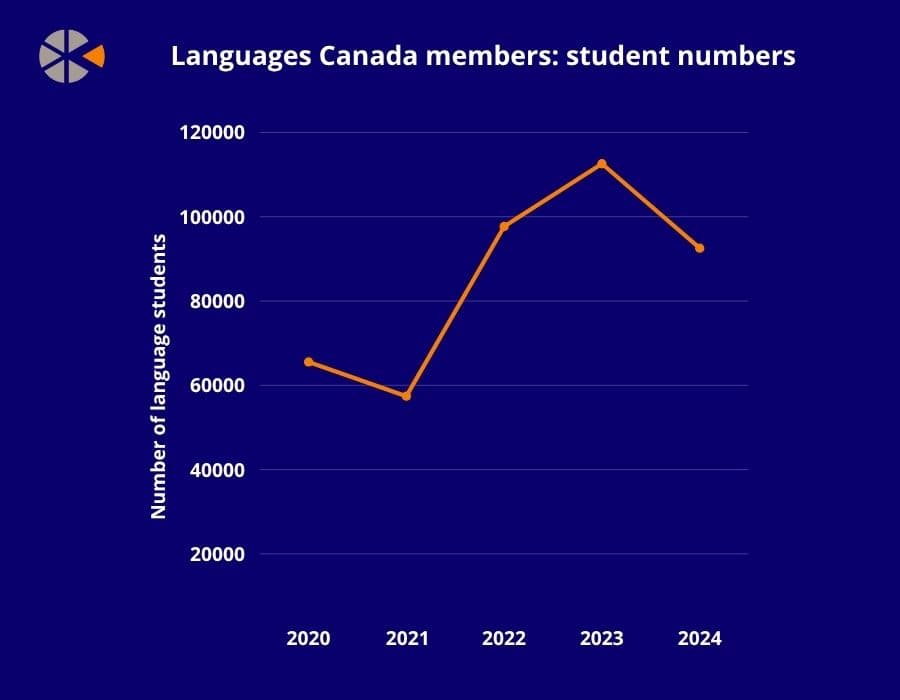- Canada’s variety of languages-to-postsecondary pathways plummeted by over half in 2024 – with stakeholders involved these figures communicate to bigger traits within the nation’s worldwide schooling sector.
- Absence of worldwide language college students being felt in school rooms, as sector pins the blame on restrictive visa insurance policies.
- Outlook higher for French language studying sector, which sees surge in enrolments as Canada pushes extra French-speaking newcomers.
The 2024 annual report from Languages Canada discovered a 56% decline in languages-to-postsecondary pathways, elevating worries concerning the knock-on impact on greater schooling.
“Language schooling is usually step one in a world pupil’s journey to postsecondary research and ultimately to turning into a contributing member of Canadian society,” Languages Canada government director Gonzalo Peralta instructed The PIE Information.
“When that first step is blocked or weakened, all the pathway is compromised,” Peralta stated, warning that with out safety of pathway applications, Canada will see a “shrinking pipeline of certified, well-prepared college students” getting into greater schooling.
Institutional income has additionally taken a success, with direct financial contributions of member faculty college students falling by 13% to CAD$1.04bn final 12 months, placing an finish to 2 years of post-Covid restoration.
In addition to dampening the “vibrancy of Canadian school rooms”, the absence of worldwide language college students is being felt on the neighborhood stage, particularly their contributions to tourism, retail and the cultural lifetime of many smaller cities and cities, stated Peralta.
“We’re not simply shedding tuition {dollars}; we’re shedding the worldwide connections and intercultural studying that make our communities stronger and extra inclusive,” he added.


Following the implementation of examine allow caps in January 2024, the sector has been hit with a barrage of federal coverage adjustments damaging Canada’s repute amongst worldwide college students.
“As soon as belief in a vacation spot begins to shake, it’s arduous to regular. And with the zig-zags in insurance policies we’ve seen, Canada actually can’t afford to fall behind on processing instances and approval charges proper now,” Saurabh Malhotra CEO of StudentDirect instructed The PIE Information.
Delays and refusals are taking place “throughout the board”, stated Malhotra, citing anecdotal accounts of refusals for India reaching their highest ranges within the final decade.
The dip in language enrolments will come as little shock to stakeholders, who say visa processing delays and ongoing uncertainty round shifting immigration insurance policies are worsening the scenario.
In response to Peralta, the visa delays stem from a myriad of things; a post-pandemic surge in purposes, evolving immigration insurance policies and new administrative procedures together with the examine allow cap and adjustments across the attestation course of.
And but, “one of many few vivid spots” was the uptick in French language applications, which noticed an enrolment improve of 14%, pushed by Canada’s push to draw extra French-speaking newcomers to help Francophone minority communities.
Not solely do these college students assist handle labour shortages in such areas, however in addition they reinforce Canada’s identification as a bilingual nation, contributing to regional improvement and linguistic variety, highlighted Peralta.
Notably, visa refusals and coverage adjustments by the IRCC had been named as the highest challenges by 82% of Languages Canada’s close to 200 member faculties, whose college students come to Canada utilizing a variety of various visas.
Final 12 months, there was an 18% improve within the variety of college students getting into Canada on short-term resident visas (TRVs) – often known as customer visas – which permit people to say within the nation for six months.
Whereas TRVs accounted for 26% of scholars in 2024, 37% got here for as much as six months with out requiring a visa, with simply 19% utilizing a examine allow. The rest had Canadian citizenship or everlasting residence.
Canada can’t afford to lose its place of belief and management in worldwide schooling
Gonzalo Peralta, Languages Canada
After years of dominance as the most important supply area for members, South America was overtaken by Asia in 2024, which accounted for 42% of all college students at member faculties.
Regardless of a year-on-year drop, Japan retained its place as the most important supply market. Elsewhere within the area, South Korea and Taiwan noticed continued progress of 8% and 9% respectively.
The survey outcomes come at a time of renewal for the sector, with language faculties calling on the federal government for better stability as they try to construct again from 18 months of federal coverage tumult.
Although the setting stays difficult, Peralta stated he remained “optimistic” concerning the promise of a extra coherent and strategic strategy from Mark Carney’s authorities, who took workplace this April.
Whereas it’s nonetheless early days, Peralta welcomed encouraging language from the brand new authorities, signalling a “renewed appreciation” of worldwide schooling and a willingness to hear.
Extra particularly, he emphasised language schooling was “not peripheral”, urging immigration minister Diab to recognise the “nuanced function” of language applications within the broader schooling and immigration ecosystems and to give attention to options balancing integrity with accessibility.

